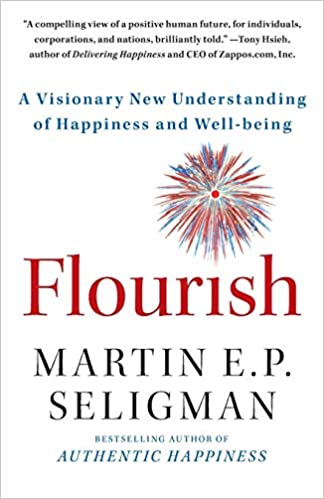Contents [hide]
Flourish: A Visionary New Understanding of Happiness and Well-Being
“In this groundbreaking book, one of the world’s foremost academic psychologists- and founder of the Positive Psychology movement- offers a new theory on what makes people flourish and how to truly get the most out of life.”
I heard someone recommend this book on a podcast I was listening to years ago (I think it was Mike Bledsloe). I bought the book at the time and only recently got around to reading it. I got some good insight and ideas from the book, but there was a lot of information around studies, which i realise is important to backup the work but it makes it a bit dry to read at times. Here are my distilled notes from what I took away from this.
——————————————————————————————————————————-
Well being
“A feeling of wellbeing is a sign of growth and that you are doing something positive for yourself
5 elements to Well Being
- Positive Emotion: Happiness and life satisfaction
- Engagement: When you are doing something and time stops, you are completely absorbed in the task
- Meaning: belonging to and serving something you believe is bigger than your self
- Accomplishment: For me this is achieving something , even if I didn’t win. It can be getting better at something and knowing I did my best. For some people it is all about winning. To them winning and having played badly (even cheated) is better than playing well and losing.
- Positive relationships: having positive people in your life you can talk to and count on
Kindness
“If you are in a bad mood, go and help someone”
Scientists have found that doing an act of kindness produces the single most reliable momentary increase in wellbeing out of any tests.
Don’t rely on external factors
“The hope that better externalities could make people lastingly happier was discouraged by a study of lottery winners, who were happier for a few months after their windfall but soon fell back to their habitual level of grouchiness or cheerfulness. We adapt rapidly to windfall, job promotion, or marriage, so theorists argue, and we soon want to trade up to yet more goodies to raise our plummeting happiness. If we trade up successfully, we stay on the hedonic treadmill, but we will always need yet another shot.”
Gratitude
Everyone is talking about gratitude and journaling these days. The author backs this up too-
“most of us are not nearly as good at dwelling on good events as we are at analysing bad events. Those of our ancestors who spent a lot of time basking in the sunshine of good events, when they should have been preparing for disaster, did not survive the Ice Age. So to overcome our brains’ natural catastrophic bent, we need to work on and practice this skill of thinking about what went well.
Flourish
The author says to Flourish we should have all of the core features:
Core features:
- Positive emotion: feeling happy and a sense of satisfaction or well being
- Engagement, interest: engaged in what you do and enjoying learning new things
- Meaning, purpose: is what I do with my life valuable and worthwhile?
We should also have three of the Additional features:
- Self esteem
- Optimism
- Resilience
- Vitality
- Self determination
- Positive relationships
Success
Achievement = Skill x Effort
Success is made of the following elements:
- Fast: Speed of thought about a task. This comes from experience
- Slow: planning, checking, creativity. The more “speed of thought” you have the more time you for “Slow”
- Rate of learning: The more knowledge you can obtain from each unit of time you work on a task
- Effort: time spend on a task
Relationships
Building Strong relationships
This model of communication can be used as a leader in the workplace or in everyday life family and friends:
- Identify and work to understand the situation
- Describe the situation objectively and accurately
- Express concerns
- Ask the other person for his/her perspective and work toward an acceptable change
- List the benefits that will follow when the change is implemented.
Active & Constructive Responding
People we care about often tell us about a victory, a triumph, and less momentous good things that happen to them. How we respond can either build the relationship or undermine it.
EG:
Your partner shares a positive event that happened to them at work:
“I received a promotion and a raise at work!”
Active and Constructive response: “This is great! I am so proud of you. I know how important this is to you. Tell me how it happened.”
Constructive: “That is good news, you deserve it”
Active and Destructive: “That sounds like a lot of responsibility to take on”
Destructive: “What’s for dinner?”
Lorada Ratio
Try to say more positive than negative things to a person. EG: with kids don’t just focus on what they didn’t do, focus on what they did do
Optimists are less vulnerable to disease
Optimists take action and have healthier lifestyles. Optimists believe that their actions matter, whereas pessimists believe they are helpless and nothing they do will matter. Optimists try, while pessimists lapse into passive helplessness.
GDP Vs Well being
The GDP of a nation is not a good indicator of the wellbeing of the people. It is better measure by how enjoyable, engaging and meaningful the citizens of the nation find their lives.
In the USA life satisfactions has been flat for 50 years, even though GDP has tripled. Depression rates have increased tenfold over the same time.
If someone has a good income and is accustomed to the high life of sun holidays, going to dinner, theatres, buying nice things etc… would their life satisfaction diminish if their income went down? All their base needs would still be covered: healthcare, food, water and shelter.
Or would life satisfaction go up? Their positive relations may improve as they spend more time cooking with their family, appreciating nature, playing games with friends etc..

